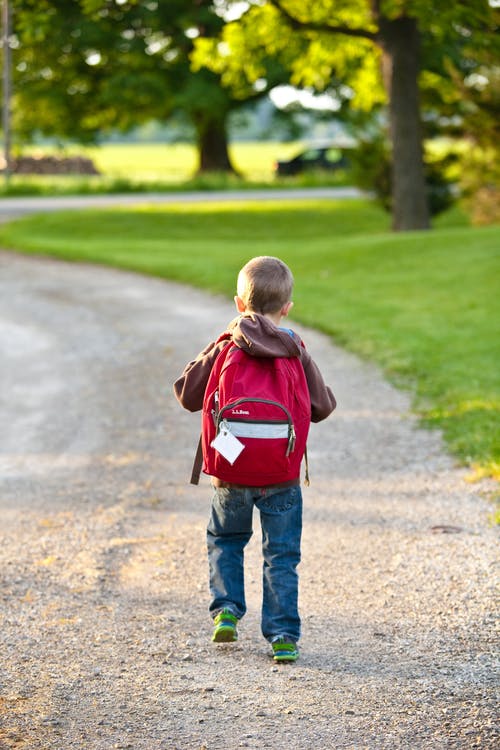
By Dr. Ali Valimahomed, M.D.
Wearing backpacks and back pain – they go together
It’s that time of year again – back to school season. This means shopping for school supplies, clothes, shoes, and maybe even a new backpack. Therefore, as we start a new school year, it’s important to pause and consider our children’s spine health. We teach them how to look both ways, to wear their seat belt, and even to wear a helmet. It’s important that we also teach them how to wear their backpacks.
Heavy backpacks place stress on backs
Unknowingly, students who wear heavy backpacks are placing themselves at risk for child back pain and may be suffering unnecessarily. The reason for this may be due to increased weight loads, such as carrying heavy textbooks, laptops, and lunches daily. Consequently, repeated carrying of heavy backpacks increases the stresses applied on the spinal structures in the back (intervertebral disc, facets, ligaments, etc) in children and adolescents.[2,8]
A 2010 study by Korovessis et al, found that heavy backpack loads are indeed responsible for a significant amount of back pain in children, which in part, may be due to changes in lumbar disc height or curvature.[9] According to a study by Goodgold et al in 2002, one-third of the children reported experiencing back pain that caused them to visit a doctor, miss school, or abstain from physical activities.[6] Furthermore, studies have shown that the prevalence of nonspecific back pain increases dramatically during adolescence – from less than 10% in the pre-teenage years, to up to 50% in 15 to 16 year-olds.[11] Additionally, the development of back pain in children is of concern since it increases the risk of developing chronic back pain in adulthood.[12]
Backpacks and bad posture
Increased time spent carrying a loaded backpack, styles of backpacks, and backpacks that are worn incorrectly may also place the wearer at risk for back pain. For example, trending styles of wear that may be associated with a greater incidence of back pain include the ‘one strap sling method’ and ‘low backpack method’. Studies have concluded that asymmetrical loads, specifically carrying weight on one shoulder (as opposed to using two shoulder straps), results in abnormal posture and walking patterns, which may cause pain in the back, shoulders, and neck.[1,3] This is largely related to the weight of the backpack greater than 15% of the child’s body weight.[10] One of the most common changes seen in children has been forward bending of the head and the flattening of the middle back curve (thoracic kyphosis), which is a risk factor for scoliosis.[5]

Child back pain leads to back pain in adulthood
To sum up, no matter how old you are, good posture is essential to your health. Incorrect postural habits are thought to begin in elementary school and thus it is important to develop healthy postural practices at a young age.[4] Studies have shown a direct correlation between back pain in children and back pain in adults.[7] Most importantly, poor posture can lead to abnormal biomechanics and increased stress on the joints, ligaments, and intervertebral discs of the back, which over time may result in irreversible degenerative changes and chronic pain.
As backpacks grow, so should your concern. That’s because improper use of backpacks and over-packing can be detrimental to the spine.
Dr. Ali Valimahomed is a pain management physician who is board certified in Interventional Pain Medicine and also Physical Medicine & Rehabilitation. He completed his residency at Cornell & Columbia, after which he finished his Pain Medicine fellowship at Harvard.
REFERENCES:
[1] Adeyemi AJ, Rohani JM, Abdul Rani MR. Backpack-back pain complexity and the need for multifactorial safe weight recommendation. Appl Ergon 2017;58:573–582.
[2] Cheung CH, Shum ST, Tang SF, Yau PC, Chiu TTW. The correlation between craniovertebral angle, backpack weights, and disability due to neck pain in adolescents. J Back Musculoskelet Rehabil 2010;23:129–136.
[3] Cho S-H, Lee J-H, Kim C-Y. The Changes of Electromyography in the Upper Trapezius and Supraspinatus of Women College Students According to the Method of Bag-carrying and Weight. J Phys Ther Sci 2013;25:1129–1131.
[4] Desouzart G, Gagulic S. Analysis of Postural Changes in 2nd Cycle Students of Elementary School. Journal of Spine 2017;06.
[5] Drzał-Grabiec J, Truszczyńska A, Rykała J, Rachwał M, Snela S, Podgórska J. Effect of asymmetrical backpack load on spinal curvature in school children. Work 2015;51:383–388.
[6] Goodgold S, Corcoran M, Gamache D, Gillis J, Guerin J, Coyle JQ. Backpack Use in Children. Pediatric Physical Therapy 2002;14:122–131.
[7] Hestbaek L, Leboeuf-Yde C, Kyvik KO, Manniche C. The course of low back pain from adolescence to adulthood: eight-year follow-up of 9600 twins. Spine 2006;31:468–472.
[8] Kordovessis P, Koureas G, Papazisis Z. Correlation between backpack weight and way of carrying, sagittal and frontal spinal curvatures, athletic activity, and dorsal and low back pain in schoolchildren and adolescents. J Spinal Disord Tech 2004;17:33–40.
[9] Korovessis P, Koureas G, Zacharatos S, Papazisis Z. Backpacks, back pain, sagittal spinal curves and trunk alignment in adolescents: a logistic and multinomial logistic analysis. Spine 2005;30:247–255.
[10] Lindstrom-Hazel D. The backpack problem is evident but the solution is less obvious. Work 2009;32:329–338.
[11] Sheir-Neiss GI, Kruse RW, Rahman T, Jacobson LP, Pelli JA. The association of backpack use and back pain in adolescents. Spine 2003;28:922–930.
[12] Wirth B, Humphreys BK. Pain characteristics of adolescent spinal pain. BMC Pediatr 2015;15:42.







